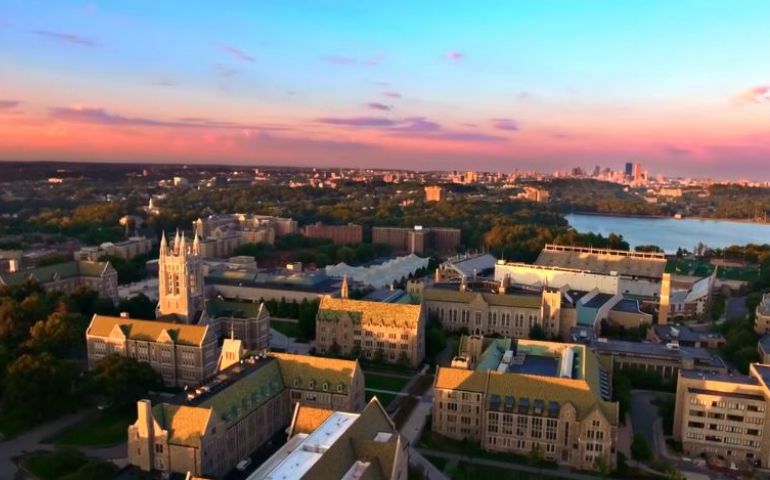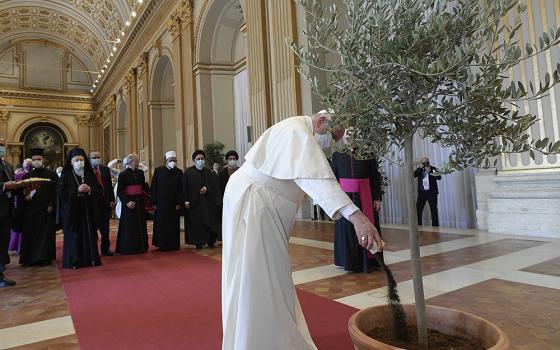
The campus of Boston College (Vimeo)
As discussed Friday, there was nothing in the Land O'Lakes document, which celebrates its 50th anniversary this year, that required or even warranted a loss of Catholic identity. Yet many schools saw precisely such a loss in the intervening years, creating in the minds of some a cause-and-effect relationship. Causality is a notoriously difficult thing to prove when dealing with complex institutions like universities, but that difficulty cannot prevent us from examining as best we can what did happen to Catholic higher education in the past 50 years.
In his massive study of the secularization of the American academy, The Dying of the Light: The Disengagement of Colleges and Universities from their Christian Churches, James Tunstead Burtchaell demonstrates that the phenomenon started with mainstream Protestant universities in the 19th century. If you have ever wondered why Ivy League campuses are dominated by over-large and under-used chapels, Burtchaell's opus explains it all. I have been to the chapels at Harvard, Yale, Brown and Princeton, and the only people I ever ran into were cleaning people and organists.
My favorite tidbit from Burtchaell: Originally, the motto of Harvard University was "Christo et ecclesiae" — "for Christ and his church"— until it was changed in 1885 to "Veritas" — "Truth" — the latter term noted at the time for its "glittering generality." Of course, by the latter half of the 19th century, Congregationalism had lost all of its Calvinist rigor. Most Congregationalists have left orthodox Christianity for Unitarianism. That the first Calvinist seminary should cease to be meaningfully religious as it transitioned first into a college, then into a university, while its founding denomination lost its doctrinal anchors, is hardly surprising.
Burtchaell overstates his argument, however, when he turns his gaze to Catholic higher education, especially his treatment of Boston College. He also examines The College of New Rochelle and Saint Mary's College of California, about which I know nothing. Describing all three, he details the "drastic trauma in the late 1960s" when the schools' founding orders "suddenly proved unable to provide plentiful leadership or scholarship." The three schools "came within touch of bankruptcy," he writes. "More significant and more interesting is the failure of nerve, the deviance of purpose, and the degradation of public discourse which have drawn these schools, severally, to abandon their calling to be ministries of the Catholic Church," he affirms, but it is an affirmation that does not ring true, at least not about Boston College.
Of course, the classical curriculum that had shaped Jesuit education changed: In the 1950s, Burtchaell notes, an undergraduate at Boston College took "ten courses for a whopping twenty-eight credits in philosophy." Today, Boston College requires its undergraduates to take 15 required courses, of which only two are in philosophy. Students also take two theology, two natural science, two social science, and two history courses, and one course each in cultural diversity, the arts, literature, mathematics, and writing. That is a pretty well-rounded set of requirements it seems to me. He notes that the number of Jesuit professors declined in the '60s and '70s, from 41 percent just before World War II to only 21 percent, but the Chestnut Hill campus still has the single highest concentration of Jesuits anywhere in the world. And he argues that the switch to a mostly lay board was detrimental to the school's Catholic identity.
I remember asking my old friend Alan Wolfe what he thought about Boston College's Catholic identity. Wolfe founded the Boisi Center for Religion and American Public Life in 1999 and led it until last year. Wolfe is not a Catholic, but he always said he was acutely conscious of the Catholic identity of the university that hosted his center. He invited me to campus when my first book came out, and I noticed that all the classrooms had crucifixes, that the chapel and church appeared well used, and the undergraduates with whom I spoke seemed very keen on discussing the Catholic Church and its public relevance.
In subsequent visits, those first impressions have been not only confirmed but strengthened. Boston College's Hosffman Ospino has done some of the most important work on the Latino apostolate in the country, Patricia Weitzel-O'Neill and Kristin Melley run the dual immersion program that is helping Catholic parochial schools around the country serve an increasingly diverse population and excel while doing it, and the theology department recently snagged one of the Catholic Church's most thoughtful scholars in Cathleen Kaveny. The annual summer meeting of young theologians that I am so blessed to be invited to has been hosted and funded by Boston College in every year but one, when Carroll College in Helena, Montana, served as our host. This autumn, Jesuit Fr. Jim Keenan, a theology professor who also runs the Jesuit Institute, will host the foremost academic conference on Amoris Laetitia in the English-speaking world. All of these people and projects highlight the compatibility of being a first-rate, modern university and a Catholic university as foreseen and called for by Land O'Lakes.

Hosffman Ospino, assistant professor of theology and religious education at Boston College's School of Theology and Ministry(CNS photo/Jaclyn Lippelmann, Catholic Standard)
Yes, there are some schools that have lost more or less of their Catholic identity since the Land O'Lakes document, although I see no direct connection between the two. The University of Notre Dame, like Boston College, adopted a largely lay board, but it hasn't lost its Catholic identity one iota. On the other hand, Georgetown University Law Center is indistinguishable from it secular counterparts except for the chapel. And, across the academy, there was a separation of knowledge and balkanization of fields that at a very deep level contradicts what we catholics believe: that all was created in him and for him and is destined to be reconciled in him at the end of time. The interdisciplinary vision called for in Land O'Lakes largely did not happen because of stronger currents in higher education.
Something else happened since Land O'Lakes: the emergence of what we may call sectarian Catholic schools. In 1974, Third Order Regular Franciscan Fr. Michael Scanlan became president of College of Steubenville and set about creating a different set of Catholic identity for the school. Three years later, Christendom College began its existence and, going to their website, one is greeted by a photo that includes Archbishop Salvatore Cordileone of San Francisco, former Sen. Rick Santorum, Dr. Scott Hahn, Mary Beth Bonacci and others. Pity the editors of Civiltà Cattolica didn't think to put that photo on the cover of their recent controversial editorial! And, in 2003, Ave Maria University emerged from the swamps of Florida.
I am sure you can find good professors at all three schools. And, while I would not suggest any parent send their child to one of these schools, because the educational model is crimped, subjected to an ideological agenda that I do not share, I will allow that these schools represent a legitimate, if unfortunate, expression of Catholic identity. Still, I have to say I was surprised when I found myself in Gaming, Austria, where Steubenville holds its study-abroad program. Normally, I thought, such programs would be associated with a local school and be situated in an urban area, from which the students can really fan out and imbibe a rich variety of cultural experiences. Gaming is a tiny town in the middle of the mountains. No chance of contamination there! And that really is what is objectionable about these schools, and objectionable on Catholic grounds: They approach modernity as a source of contamination and seek an isolated, immunized system of thought to protect themselves. You can find this disposition in almost any century of Catholic history, but I do not see how it serves well as a basis for a Catholic education.
A variety of complex social and economic factors were also at work in these last 50 years. Every year since 1967, the requirement of a bachelor's degree for certain professional jobs and the proliferation of those professional jobs have been remarkable. The cost of higher education has also ballooned, necessitating federal involvement in the form of student aid programs. Desegregation had begun in the 1950s but became thorough-going in the 70s and 80s. The precipitous decline in the number of women and men religious affected those Catholic schools run by religious orders. Etc. As I say, causality is a difficult thing to pin down.
Burtchaell makes much of transfer of institutional authority from a clerical board to a lay one, a point I will address in the next essay but about which I think he is wrong. He is correct that for many Catholic schools the loss of Catholic identity had to do with the shrinking percentage of Catholics in the faculty and student body. You can't have a Catholic university without Catholics. But in the time since his book was published 19 years ago, many Catholic universities have begun to "hire for mission" to address this problem.
Wednesday, I will conclude the series by rebutting some of the critiques of Land O'Lakes that seem especially unfortunate and posing a question I have posed before: Why is "Catholic identity" almost reflexively assumed to be a conservative thing?
[Michael Sean Winters covers the nexus of religion and politics for NCR.]
Editor's note: Sign up to receive emails, and we will notify you when Michael Sean Winters publishes new Distinctly Catholic columns.



